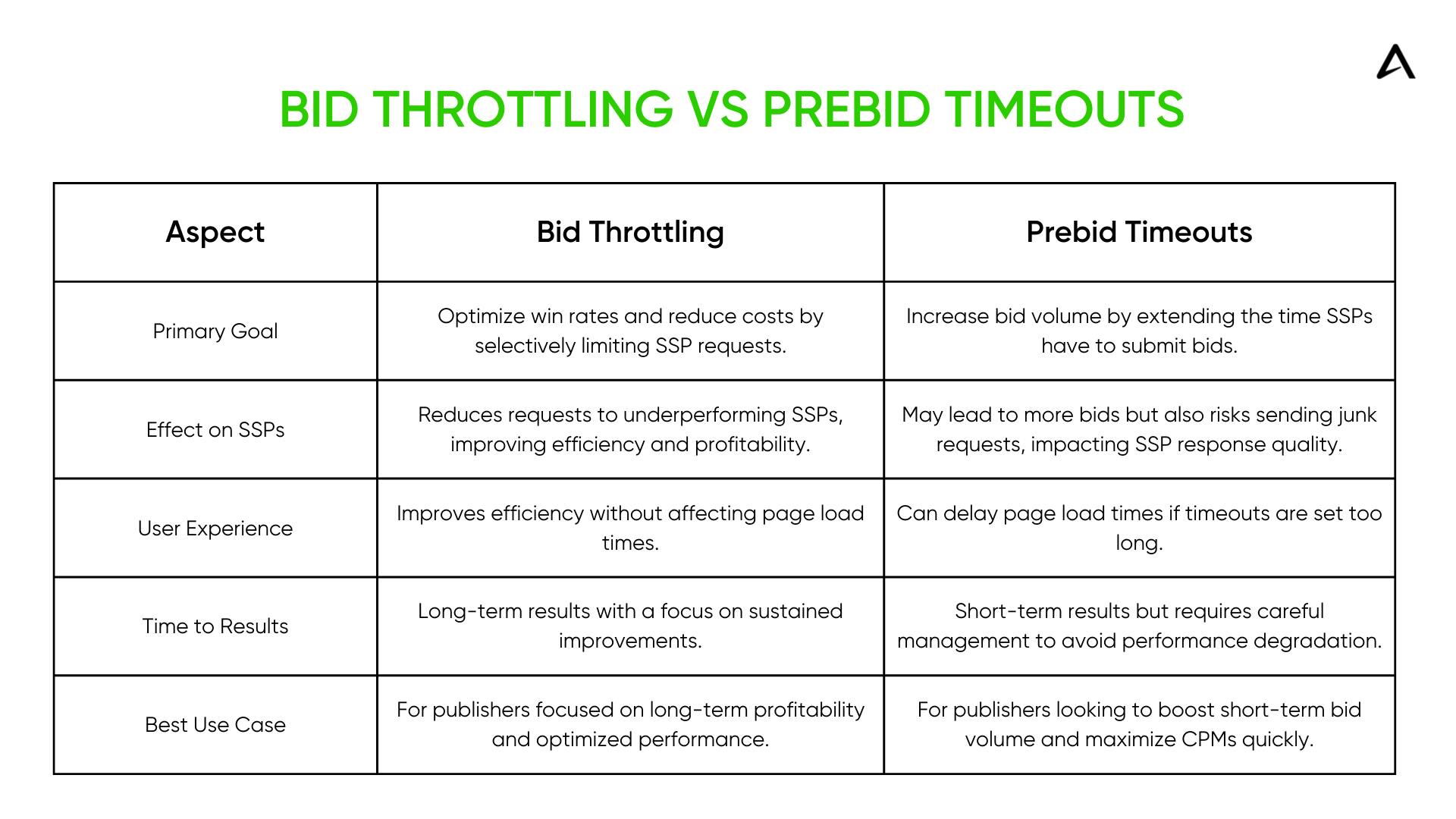Bid Throttling vs. Prebid Timeouts: Understanding the Differences and Best Practices for Maximizing Ad Revenue
The programmatic advertising industry is constantly evolving as publishers and advertisers aim to maximize revenue and enhance the user experience. This blog explores the key differences between bid throttling and prebid timeouts, how they work, and best practices for implementation.

The programmatic advertising industry is continuously evolving as publishers and advertisers seek ways to maximize revenue while optimizing the user experience. Two common techniques used to manage bid requests in real-time auctions are bid throttling and prebid timeouts. Both approaches aim to improve ad performance, but they do so in different ways and offer distinct advantages depending on the publisher's goals. In this blog, we will explore the key differences between bid throttling and prebid timeouts, compare how they work, and discuss best practices for implementation.
Introduction
In the programmatic advertising ecosystem, ad exchanges and supply-side platforms (SSPs) rely on real-time bidding (RTB) to auction off ad inventory. The goal is to deliver the most relevant ads to users while maximizing the revenue generated from those impressions. However, managing the vast number of bid requests and auction processes can be challenging, particularly when dealing with multiple SSPs, different types of demand, and varying bid volumes. To address these challenges, publishers often implement strategies like bid throttling and prebid timeouts to optimize the auction process and ultimately improve ad performance.
While both bid throttling and prebid timeouts can positively impact revenue, they function in fundamentally different ways. Let’s dive into each of these techniques to better understand how they work, their benefits, and best practices for implementing them effectively.
What is Bid Throttling?
Bid throttling, also known as traffic shaping, is a strategy that controls the volume of bid requests sent to SSPs during an auction. Essentially, bid throttling limits the number of bid requests made by a publisher to certain SSPs, either by reducing the frequency of requests or cutting off requests to particular SSPs entirely when certain conditions are met.
The concept behind bid throttling is simple: by selectively calling SSPs based on specific criteria—such as bid volume, demand quality, or historical performance—publishers can improve the efficiency of the auction process. Throttling requests to low-performing SSPs or those with lower-quality demand can reduce unnecessary requests, resulting in better outcomes for both the publisher and advertisers.
How Bid Throttling Works
Bid throttling works by adjusting the frequency at which bid requests are sent to SSPs. Publishers can throttle the volume of bid requests in real time by cutting out certain SSPs during an auction, effectively reducing the number of competing bidders for each impression. This can be done by limiting the number of calls to SSPs based on predetermined thresholds, such as:
- Bid win rate: If a certain SSP has a low win rate, the publisher may reduce the number of requests made to that SSP.
- Cost per request: Higher cost per request can make the auction less profitable, so cutting back on SSPs with high costs can help improve profitability.
- Performance metrics: Publishers may choose to throttle based on metrics like click-through rates (CTR) or conversion rates.
By implementing bid throttling, publishers can increase their win rates, reduce bid request costs, and ultimately drive more profitable outcomes. This process also reduces the risk of sending too many low-quality requests, which can result in poor performance and lower earnings. While it may take some time to see results, the long-term cyclical effect of bid throttling can lead to significant value.
What are Prebid Timeouts?
Prebid timeouts refer to the time a publisher allows for an auction to run before deciding which bid to accept. This timeout period is critical in determining how long the system will wait for bids from various SSPs before closing the auction and selecting the highest bid. Prebid timeouts are typically set based on a publisher’s needs for speed versus yield.
In simple terms, prebid timeouts dictate how long the system waits for a bid before considering the auction closed. This can be configured in prebid.js, the open-source header bidding framework used by many publishers. Longer timeouts give SSPs more time to submit bids, potentially resulting in more competitive offers. However, if not carefully managed, longer timeouts can lead to more “junk” requests—bids that ultimately don’t add value.
How Prebid Timeouts Work
The prebid timeout mechanism is essential for controlling how long the auction process will wait for bids from various SSPs. The auction is initiated when a user visits a page, and the header bidding process starts by making bid requests to the selected SSPs. Each SSP has a specific timeout setting, indicating how long it will take to respond with a bid. Once the prebid timeout threshold is reached, the auction ends, and the winning bid is selected based on the highest offer.
- Increasing timeouts: Longer timeouts allow for more bids to come in, which can increase competition and yield higher CPMs.
- Bid caching: Enabling bid caching is a critical step when increasing timeouts. This ensures that cached bids can be reused efficiently, reducing the need for repeated requests.
- Potential drawbacks: While longer timeouts can increase bids, they may also result in more junk requests that SSPs are less likely to bid on, negatively impacting auction quality.
Comparison of Bid Throttling and Prebid Timeouts

Best Practices
Bid Throttling/Traffic Shaping
- Stop calling low-performing SSPs: Identify SSPs with low win rates or high request costs and reduce or eliminate requests to these platforms.
- Cut requests selectively: Focus on individual SSPs within auctions that underperform. Over time, this approach improves win rates and lowers costs.
- Think long-term: While bid throttling might not show immediate results, its cyclical benefits—improving auction efficiency and profitability—are significant.
Prebid Timeouts
- Enable bid caching: Longer timeouts require bid caching to avoid creating excessive junk requests.
- Set realistic timeouts: Allow timeouts to extend slightly longer to capture more bids, but don’t overextend and compromise user experience.
- Use in combination: Pair prebid timeouts with bid throttling for a balanced approach to maximizing both bid volume and quality.
Conclusion
Bid throttling and prebid timeouts are both powerful tools in a publisher’s programmatic advertising strategy. Bid throttling focuses on long-term efficiency and profitability by selectively reducing SSP requests, while prebid timeouts aim to maximize short-term bid volume by extending the time auctions remain open. The choice between the two depends on your goals—whether they are long-term growth or short-term revenue optimization.
For most publishers, a balanced approach using elements of both techniques will yield the best results. Implementing these strategies thoughtfully, while adhering to best practices, ensures a robust auction process that maximizes revenue and maintains a high-quality user experience. If you have questions about bid throttling or prebid timeouts, reach out to our team at adops@aditude.io.




